
RJIF launched an investigation into the contemporary Japanese living environment as the first project in our “Rediscover Japan” project. While Japanese architects are highly lauded, little is known about the residential environment in which “normal” people live.
Once maligned as “rabbit hutches” by disdainful Europeans, Japanese homes deserve a reassessment. Not only has the quality of houses has improved to the point where new builds are superior in quality to the U.S. and European homes they were initially meant to emulate, thanks to a rapid construction turnover that accelerated innovation and technological refinement, but the way people use their homes has also greatly evolved.
As the population shrinks and ages, the countryside hollows out, and people seek to reverse the environmental damage and loss of community wrought by rapid industrialization, new and diverse ways of using and adapting housing are emerging in Japan.
From eco-conscious people living in “zero energy” houses, young people cultivating vegetable gardens in the city, multi-generational communes, wooden skyscrapers and creative crashpads where “sharing” is promoted and ownership discouraged, the range of burgeoning lifestyle movements suggests the stereotype of overworked salarymen stuffed in one-room apartments no longer holds true in Japan.
We are publishing a series of articles framed around interviews with people leading such lifestyles to reveal the often overlooked innovation, creativity and flexibility in Japan’s living environment and to show how these growing movements can be relevant for other countries facing similar social, demographic and environmental pressures.
The Energy Revolution At Home
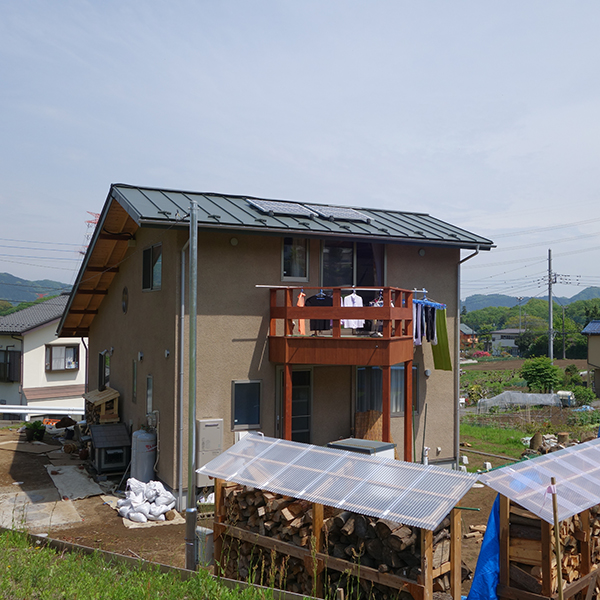
The exterior of a house using an off-grid energy system installed by local community organization, Fujino Power. (Photo: Sophie Knight)
While Japan’s energy industry is heading towards deregulation and liberalization, local energy projects at a regional level are also spreading. Some communities are already empowering people to choose their electricity provider, by supplying locally-generated energy alongside electricity from the grid of utilities such as Tokyo Electric Power Co (TEPCO). We looked into the various measures being taken at the individual, regional and national levels in response to Japan’s energy problems.
The results of our findings on energy titled “Harnessing the power of community to drive an energy revolution” were published in the Japan Times on June 5, 2015.
In response to climate change, the rising cost of resources such as oil and gas, and the increasing risk of both natural and manmade disasters such as Fukushima, various efforts to tackle energy consumption have emerged, from the local to the governmental level.
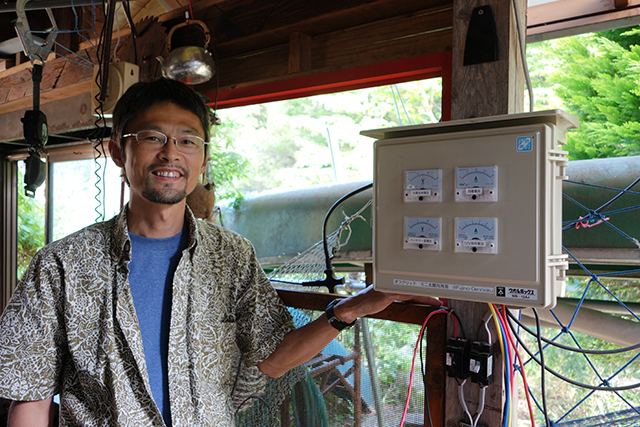 Mr. Shotaro Suzuki, a project manager at Fujino Power
Mr. Shotaro Suzuki, a project manager at Fujino PowerSome individuals and communities have begun shifting towards “off-grid” lifestyles, generating energy themselves and reducing their dependence on the grid of major utilities such as Tokyo Electric Power Co (TEPCO). Most of these projects depend on solar power and storage batteries. Obviously, such lifestyles require a certain amount of conscious effort.
Requiring somewhat less commitment is the “zero energy house” (ZEH), a commercial answer to Japan’s energy woes. ZEH use solar panels and storage batteries and a well-insulated, airtight construction to ensure that the household produces more energy than it consumes over the course of a year. The reduction in energy bills and tax incentives provided by the government are expected to increase the popularity of ZEH, as well as the “home energy management system” (HEMS) that enables residents to see how much energy they are consuming and to reduce their use of appliances accordingly.
On a larger scale, there are many groups and NPOs promoting local energy projects that generate and distribute energy throughout a community, independent of the major regional utilities. Many of these are detailed in Masaki Takahashi’s “Local Energy Projects Have Started” book, published earlier this year. Takahashi says there are as many as 100 local projects around the country, and emphasizes that the movement has moved beyond a black-and-white dialectic of pro and anti-nuclear camps. We visited one such community project, Fujino Power, based in Kanagawa Prefecture, which teaches workshops on how to make simple solar batteries, orchestrates solar-power music festivals, and installs a solar-power based system in people’s houses that uses Chinese-made panels and car batteries for a tenth of the price that commercial versions of such systems usually cost. Light switches and appliances run off the system are kept distinct from switches that are powered by TEPCO.
Another community-based project is the Sun Self Hotel in Ibaraki prefecture, where an apartment building has been converted into an off-grid hotel by local residents.
Although the Japanese government introduced a system for individuals to sell energy back to the grid in 1992, this scheme only gained attention in 2012, when a fixed price for energy buybacks was decided. However, several regional utilities have said they will stop signing new contracts to buy back solar energy because their grids cannot handle the surges in power, while Prime Minister Shinzo Abe’s administration announced extremely lackluster targets for renewable energy in the government’s 2014 Basic Energy Plan, disappointing those hoping for an energy revolution post-Fukushima.
Interviewees:
| Tsuyoshi Seike: | Associate professor at the Graduate School of Frontier Sciences, University of Tokyo |
| Masaki Takahashi: | Freelance journalist and author of “Local Energy Projects Have Started” |
| Shuntaro Suzuki: | Project manager of Fujino Power in charge of installing solar systems into local residents’ houses |
| Kazuaki and Haruko Hashimoto: | The latest household to install a Fujino Power system |
The Wooden Metropolis: How Advances in Fireproofing Timber Could Change Urban Japan
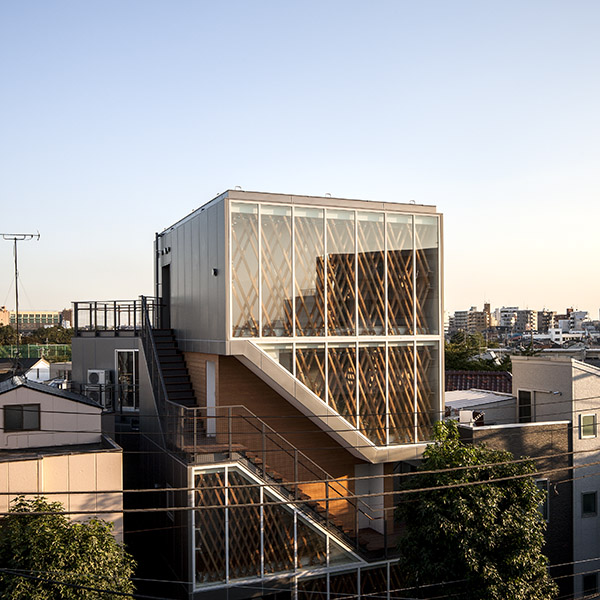
The exterior of an apartment built by team Timberize member Mr. Eijiro Kosugi at his architectural firm KUS (Photo: Satoshi Asakawa)
While the industrial and distribution sectors in Japan have both reduced their carbon emissions, there is a lot of room for improvement in the private sector. One potential measure could be increasing the use of wood in construction. Improvements in the technologies used to fireproof timber mean that it has become possible to build mid-rise wooden buildings even in earthquake-prone Japan. A new urban landscape filled with timber rather than steel and concrete may be just around the corner.
The results of our findings titled “Tokyo designers push the boundaries of wooden skyscrapers” were published in the Financial Times’ “House & Home” section on July 3, 2015.
Japan’s poor management of its cedar forests, its embracement of concrete to reduce fire risk and a dwindling market for new builds has produced a perfect storm for the domestic timber market. Now, as urban planners call for further eliminating wooden structures from the cityscape to avoid blazes, architects and construction companies are pushing back with innovative fireproofing technologies that could make wooden skyscrapers a reality.
 A model of a stadium that team Timberize designed with the Tokyo 2020 Olympics in mind. (Photo: Satoshi Asakawa)
A model of a stadium that team Timberize designed with the Tokyo 2020 Olympics in mind. (Photo: Satoshi Asakawa)Japan’s unusually fast turnover of buildings—-the average structure in Tokyo is just 20 years old—makes use of steel and concrete environmentally untenable due to the waste they produce. Increased use of wood in construction would also reduce CO2 emissions, which have rocketed since 2011 as Japan burns more oil and gas to make up for an energy shortfall post-Fukushima. Unlike the industrial and distribution sectors, private industry has failed to cut its carbon emissions, of which a large part comes from the construction industry.
Since younger trees absorb more CO2 than older trees, it is vital to maintain the harvesting and replanting cycle in forests. Inhibiting the use of the country’s surplus cedar stocks, however, is a topsy-turvy market in which raw domestic cedar is the world’s cheapest wood but more expensive than imported logs once processed, due to a failure to integrate the production chain.
As a result, domestic wood makes up only 30 percent of the domestic timber market. Japan’s forests are deteriorated and the industry is shrinking because the costs of drying and processing lumber in a complicated supply chain makes it far more expensive than imported wood. Domestic producers also can’t handle large orders within a short time frame unlike European, Canadian or Russian producers, leaving construction firms and home builders reliant on imported timber. As a result, fewer trees are cut down and replanted, less carbon is offset and environmental disasters such as landslides are occurring more frequently.
However, there is hope: a revision to the building code in 2000 loosened the regulations on building with wood, making it possible to use exposed timber that employs certain fireproofing technology. Two of Japan’s biggest construction firms, Takenaka Corp and Kajima Corp, have both developed engineered lumber that can withstand one hour of fire, and are aiming to get two-hour versions certified next year. Takenaka used its one-hour timber, trademarked as “Moen-wood”, to build Southwood, Japan’s first wooden shopping mall in 2013 in Yokohama.
More recently, another law has come into effect that obliges local governments to use as much wood in public buildings as possible.
One group taking advantage of the relaxed regulations is team Timberize, an NPO founded by architects going against the grain by proposing multi-story wooden office buildings, apartment blocks and even wooden stadiums and arenas for the 2020 Olympics, while meeting Japan’s stringent—some say excessive—fire regulations. One member of the group was able to build a five-story wooden building in Tokyo in 2013 using another type of fireproofing technology that would allow the structure to burn for one hour without collapsing.
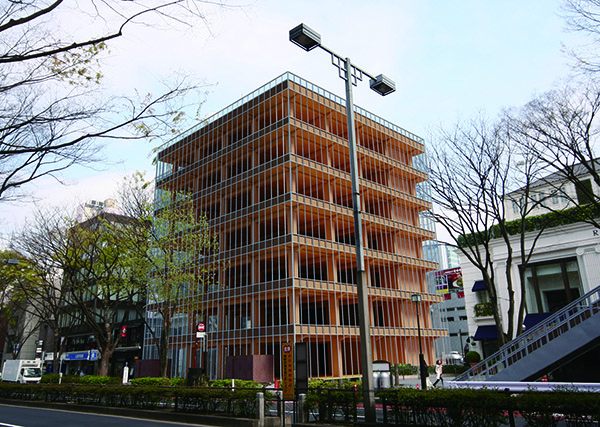 A CGI illustration of ’30’, a high-rise wooden building designed by team Timberize and named after its height in metres. (Provided by team Timberize)
A CGI illustration of ’30’, a high-rise wooden building designed by team Timberize and named after its height in metres. (Provided by team Timberize) An aversion using wood has spread to the interiors market, too, as companies shy away from using wood in industrial products for fear of customer complaints that it is too easily damaged or irregular. Fighting against that tendency is the 1,800-member strong “Country Covered in Cedar Club”, a consortium of architects and designers trying to increase use of Japanese cedar in wooden furniture and products and boost regional economies by using their surplus cedar stocks. As a result of their efforts, local cedar supplies have been used to build bridges, children’s playrooms and even clad cars on a local train line in Kyushu.
Interviewees:
| Mikio Koshihara: | Director of the NPO team Timberize and a professor specializing in timber construction at the University of Tokyo’s Institute of Industrial Science. |
| Eijiro Kosugi: | A director at NPO team Timberize and a professor of architecture at Akita University |
| Koichi Wakasugi: | A product designer at Power Place and the founder of Country Covered in Cedar Club |
| Kaoru Shibahara: | CEO of Nagiso Forestry and supplier of wood for Ise Shrine Alastair Townsend, co-founder of Tokyo-based architectural practice Bakoko |
Housing Solutions for Disaster Survivors
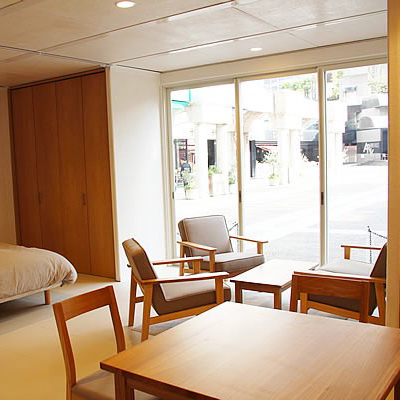
Daiwa Lease’s disaster housing block, designed by architect Shigeru Ban (Provided by Daiwa Lease)
Japan, one of the world’s most disaster-prone countries, owns some of the world’s most advanced seismic proofing technologies. However, it became clear after the earthquake, tsunami and nuclear crisis that struck in March 2011 that the supply chain for temporary housing for victims of disasters was insufficient in many ways, including speed. Daiwa Lease, a subsidiary of the Daiwa Group, teamed up with architect Shigeru Ban to solve the problem of how to supply a large volume of housing in a short space of time, by developing a housing unit produced in an emerging nation where it can also be used as low-cost accommodation the rest of the time.
The results of our findings were published in the online business magazine Quartz on July 9, 2015.
Solutions for the Vacant Home Epidemic
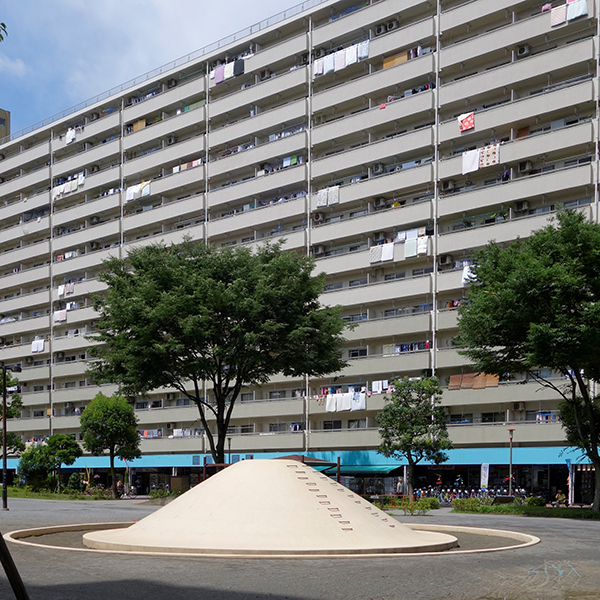
The apartment block in Takashimadaira, Tokyo, where Muji renovated several units. (Photo: Sophie Knight)
Japan has 8 million empty homes, or around 13 percent of its entire housing stock. To reduce the number of vacant buildings, the government enacted a law at the beginning of 2015 to be able to take over and demolish those for whom owners cannot be found. At the same time, several businesses have begun projects to make better use of unoccupied houses, including sharing schemes. Japan’s housing agency, Urban Renaissance, has also teamed up with lifestyle brand Muji to renovate the interiors of aging apartment blocks to attract a new generation of young residents, while real estate company R Fudosan leads the pack in demonstrating the value and charm to be found in secondhand properties.
The results of our findings were published in the online business magazine Quartz on September 14, 2015.
By 2033, a third of all homes in Japan will be vacant. Depopulation, the hollowing out of the countryside and post-war policies encouraging new builds have conspired to create perhaps the shortest rebuilding cycle in the world of just 20 to 30 years, perhaps the fastest in the world. In 2009, the number of new builds finally dropped below 1 million, but Japan’s housing stock is still expanding. Until now, strong land rights have prevented the government from bulldozing unclaimed properties, which grow ever more dangerously unstable and more of a fire risk the longer they stand. Those built before 1980 are also seismically unsound as they do not meet the most up-to-date standards.
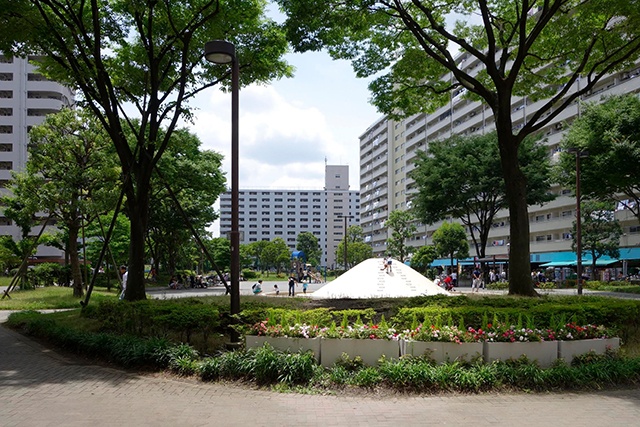 The apartment block in Takashimadaira, Tokyo, where Muji renovated several units. (Photo: Sophie Knight)
The apartment block in Takashimadaira, Tokyo, where Muji renovated several units. (Photo: Sophie Knight)But the tide is changing: the law recently changed to allow authorities to take control of abandoned builders for whom the owners are unknown. The renovations market, once tiny, is rapidly growing, fueled by the younger generation’s appetite for retro style over new white boxes.
Muji, Japan’s most famous interiors export, has gotten in on the trend. It has teamed up with Urban Renaissance (UR), a rebranded version of Japan’s postwar housing agency, to renovate ageing “danchi”, or apartment blocks built to solve a housing shortage through the 1960s and ‘70s. Surrounded by open green parks and cleverly built, Muji is hoping to bring out the original charm of the danchi for a younger generation by reforming the family units into bright, open-plan studios.
Another company that has brought attention to renovated and unique or quirky properties around Japan is R Fudosan, an estate agent that started from a Tokyo base and has now expanded to nine locations. The parent company SPEAC also do consulting, planning and design for both newly built properties and second-hand ones where they aim not to make it look brand new, but rather leave a little of its original flavor intact. Doing so is important to increase the value of second-hand properties in Japan, which only make up 13 percent of house purchases at present.
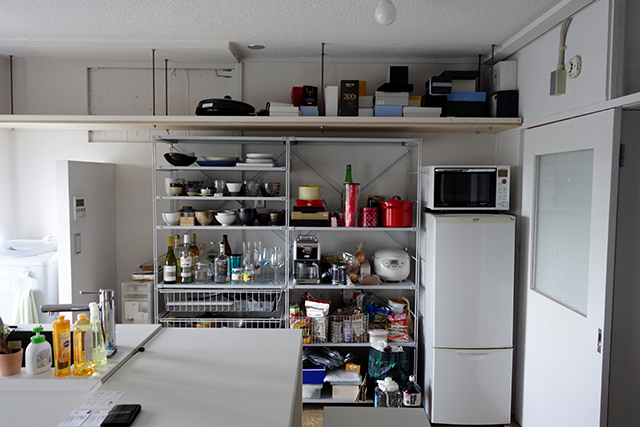 The interior of an apartment in Takashimadaira which Muji renovated.
The interior of an apartment in Takashimadaira which Muji renovated. There are solutions other than renovation, too. Estate agent Able and holiday accommodation website Tomareru have teamed up to create a matching service for people to stay in properties in special economic zones, exploiting a legal loophole—Airbnb, a U.S. home-sharing service, is still regarded as illegal due to the hotel law in Japan. Tomareru has also set up a service known as “Tomarina” to allow people to stay on farms to experience rural life.
Interviewees:
| Atsumi Hayashi: | Director of Speac Inc and manager at R Fudousan |
| Kouji Kawauchi: | Director of Muji House’s Dwelling space operation division |
| Jun Adachi: | Sales and development manager at the East Japan section of UR |
Dealing with an Aging Population At Home
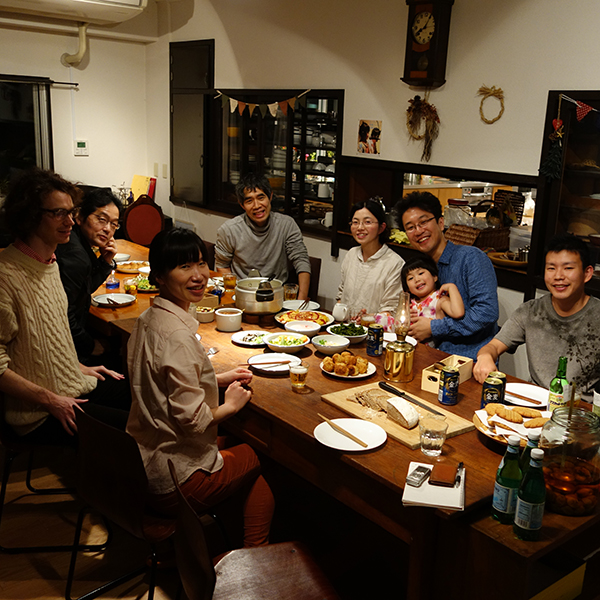
A multi-generation share house in Yokohama. (Photo: Sophie Knight)
How can society adapt to an ageing society? While there are an increasing number of medical services to serve the elderly in their homes in Japan, there are also schemes such as “Grandma Concierge”, a service in which a grandmother cooks nutritious meals and helps with laundry and cleaning at a shared house of people in their 20s and 30s, that recognizes older people can contribute to the younger generation with their energy and wisdom, rather than casting them as passive receivers of care. We looked at various programs developed by both companies and municipal governments to ensure that people live long and fulfilled lives while contributing to society.
The results of our findings titled “A Greater Share for the Japanese Sharehouse” were published in the Nippon.com on March 2, 2016.
It is no secret that Japan has the fastest-ageing population on earth. While much of the discourse is pessimistic, focusing on the social upheaval that a graying society will cause, it is also an opportunity for Japan to take the lead and show other countries how to deal with a shrinking workforce and a swelling number of pensioners, many of whom require care.
One of the measures the government is taking is gradually raising the age at which people can receive their pensions, which will reach 65 in 2025. However, while encouraging people to work later in life is important to deal with this demographic shift, it is also necessary to take into account the decrease in physical strength and mobility that goes with age, and design a suitable living and working environment. As can be seen in the “Basic Living Plan” approved by the Japanese cabinet in 2006, measures are being taken to ensure that people can remain living in their homes for as long as possible by installing “barrier-free” equipment that makes their living environment more accessible.
Beyond hardware solutions, Japan is also applying technology to offer more flexible services to older people. The use of robots, sensors and the cloud in cutting-edge medical technologies is expected to grow, while flexible services such as a traveling doctor, dentist, library and grocery delivery around depopulated rural areas to serve ageing populations are also on the increase. In urban areas, there are several apartment blocks that offering a “watching” service for people over a certain age, keeping details of their health ailments in case of emergencies as well as hosting get-togethers and frequent events to prevent isolation. This is particularly important as the shift away from multi-generational households to single-person dwellings in the past forty years has resulted in increased social alienation and fewer options for care for the elderly.
As part of the recognition of the importance of reviving community ties, multi-generational communal houses shared by unrelated people like those found in Germany and the UK have also emerged. But unlike other countries, communal houses in Japan such as Kan Kan Mori seek to invoke and re-interpret the culture’s traditional living arrangements that precede the nuclear family rather than invent a new way of living. We talked to gerontology experts and sociologists to examine how this trend will grow and how Japan’s efforts in keeping its elderly spritely by looking to its past could serve as lessons for other countries.
In the same vein, a number of multi-generation collective houses and sharehouses where childcare duties and household errands are shared by the parents have also emerged and look set to increase in number. One idea that marries multi-generational living with increased employment opportunities for the over-60s is the “Grandma Concierge”, a sharehouse in Yokohama that recreates the warmth and wholesome cooking everyone associates with their grandparents by having a grandma come by three times a week to cook dinner, clean the living room and do the laundry for six twenty-somethings that live in the house. The women who work in the scheme are delighted to be appreciated for domestic tasks that go unthanked and taken for granted at home, while the residents, like overworked singletons everywhere, are grateful to come back home to a home-cooked dinner and freshly laundered clothes a few times a week.
This is just one of a host of initiatives in Japan that turn the idea of the “old” as a burden on its head, drawing on the wisdom, skills and industriousness of its baby boomers to support the younger generation. There are also projects at a national and regional level that address the other part of Japan’s demographic problem: a falling birth rate, which, along with rural flight, is hollowing out the countryside. Two prominent examples are the towns of Kamikatsu and Kamiyama in Tokushima prefecture: the former created a company called Irodori employing old people to pick and process decorative leaves used in Japanese cuisine, while the latter introduced a “work in residence” program that has brought more young people into the local area.
Interviewees:
| Florian Kohlbacher: | Professor of marketing in the International Business School Suzhou (IBSS) and head of the aging and society research initiative at Xi’an Jiaotong-Liverpool University (XJTLU) |
| Yosuke Sakai: | Director of Syoue Kensetsu, a real estate and construction company |
| Junko Iwai: | The first employee of “Grandma Concierge” |
| Mineyuki Kaneyama: | Welfare and care worker at Care Work Tsurumaki, Tokyo |
| Ken Sakamura: | Professor of Information Science at the University of Tokyo |
A Healthy Living Environment
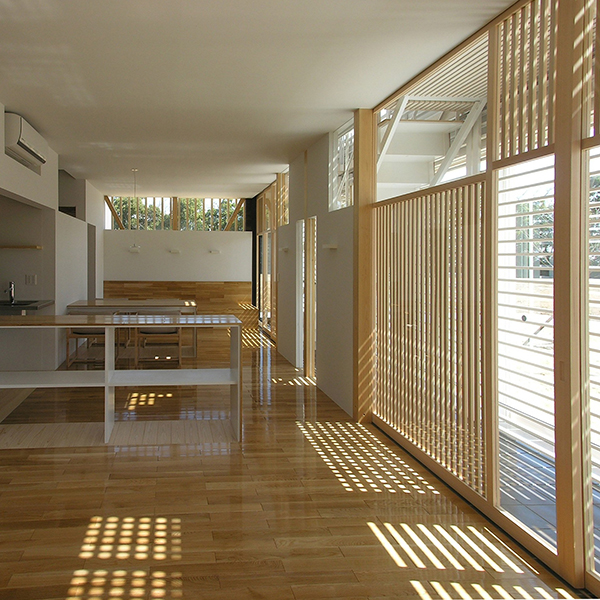
The Life Cycle Carbon Minus model house (Photo: Koizumi Atelier)
Japanese houses are built mainly with the hot and humid summers in mind, prioritizing ventilation over insulation to prevent homes from molding. While energy consumption in Japan for temperature control is lower than in other industrialized countries, as people tend to only heat or cool the rooms they are using, homes are dangerously cold in the winter and the difference in temperature between rooms can cause a lethal condition known as “heat shock”. We looked at the “Life Cycle Carbon Minus” (LCCM) house and OM Solar, eco-friendly homes that use little to no active heating while maintaining a stable temperature even in Japan’s extreme climate.
The results of our findings titled “Japan’s house for all seasons” were published in the Financial Times’ “House & Home” section on 13 November, 2015.
Designing houses that can withstand Japan’s intensely humid summers and bitterly cold winters is a challenge. Traditionally, Japanese houses are built with the damp and tropical months of July and August in mind, with flimsy walls, paper divisions and drafty corridors to increase airflow and prevent mold—but at the expense of the inhabitants’ comfort during the colder months. MLIT found in a 2012 survey that the proportion of houses that met energy-saving standards was just 5 percent and a whole 39 percent of houses were un-insulated.
While most people cope by blasting air conditioning in the room they are using or huddling under heated tables known as kotatsu, going from a hot room into a cold one can cause “heat shock”, which kills more elderly people every year than car accidents.
Enter the LCCM home, which “changes its clothes” through the seasons to adapt to the extreme swings in temperature and humidity. The house, devised by a team of architects and researchers funded by the government, sheds its outer windows in summer and slips on a coat of wooden slats instead to create a cool enclosed space under the eaves, with a “buffer” zone preventing the rest of the house from getting too hot. In the winter, the windows close to trap solar heat and warm the house.
Although LCCM’s original remit was environmental—the researchers were aiming to make a house that absorbed more carbon than it emits over its entire life cycle from construction to demolition—homebuyers are rarely swayed by only eco credentials.
Touting health benefits, on the other hand, is a sure-fire way to get consumers interested, says Akihisa Iida, the CEO of OM Solar, a company that have patented a type of “passive house” using solar heat, which is better suited to Japan’s humid climate and ample sunlight than German or Scandinavian passive houses.
Ichijo Homes knows that well: the Japanese homebuilder’s ultra airtight houses were the first in Australia to win recognition from the National Asthma Council for their superior air quality thanks to an HVAC system that filters out pollen and dust — an accolade that has left the company with such a long waiting list they are now turning down interview requests.
All three houses are at the cutting edge of a movement to promote healthy housing in Japan, an oft-overlooked goal during the country’s high-growth period and one that has been difficult to achieve until now without using a lot of energy-intensive air conditioning. As the country now concentrates on quality over quantity in housing, the emphasis on healthy homes is growing. Japan may have come late to the idea of healthy housing, but its contributions to the genre look likely to gain traction fast.
Interviewees:
| Shuzo Murakami: | President of the Institute for Building Environment and Energy Conservation (http://www.ibec.or.jp/murakami_profile.html), Professor Emeritus at the University of Tokyo |
| Akihisa Iida: | CEO of OM Solar (http://www.omsolar.net/en/) |
| Tsuyoshi Seike: | Associate professor at the Graduate School of Frontier Sciences at the University of Tokyo |
| Masao Koizumi: | Founder of architectural practice Koizumi Atelier, professor of engineering at the Department of Architecture and Building Science at the Tokyo Metropolitan University and researcher for LCCM (Life Cycle Carbon Minus) home |
 APIニュースレター 登録
APIニュースレター 登録